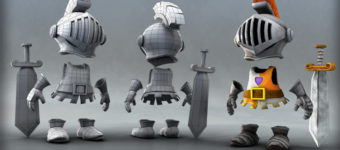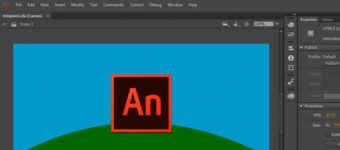
15 Best Maya Books From Beginner To Advanced
The 3D design software Maya is a must-learn program for entertainment artists. This is used with pretty much all production pipelines from 3D animated films to simpler 2D animations like South Park.
But aside from animation it’s common for concept artists to learn Maya since it’s a huge part of video game development.
That’s why I’ve curated the best books on learning Maya ranging from novice resources to more advanced titles. No matter what you want to learn or your skill level there’s something in this list for you.
Note: If you’re more of a visual learner check out Pluralsight’s Maya video courses. These cover everything about Maya and you can test ’em out with a free trial account.
Getting Started in 3D with Maya


If you’re a complete beginner having never used Maya before in your life then pick up a copy of Getting Started in 3D with Maya.
The author Adam Watkins teaches you all about the interface and the various tools you can use in Maya. This is very helpful just so you understand why Maya is so popular and what it can do.
Early chapters talk about modeling and setting up scenery for a mock video game. This also covers organic modeling for creatures, lighting, rendering, complex textures, and even some basic animation.
This is a true beginner’s book and it gets into every little nook & cranny you’d want to learn.
With each project you’ll pick up a new skillset and you even get homework to practice on your own. This forces you to learn Maya from a pragmatic point of how you’d use it every day on the job.
Maya At A Glance


If you’re more of a visual learner then Maya At A Glance takes a novice-friendly approach to teaching.
This book assumes no prior knowledge of Maya or any 3D design program. Every chapter includes a ton of screenshots with guided tutorials to help you work through the content.
If you prefer a visual guide then you’ll love this book. It explains things with a “how-to” writing style so you’re learning how to manipulate objects on the screen and create new 3D renderings from scratch.
Just note this is far from a complete guide to Maya. If anything this is the tip of the iceberg, yet it’s just enough information that it’ll whet your appetite for the software and leave you experienced enough to forge ahead on your own.
Introducing Autodesk Maya 2016


The team at Autodesk publishes their own books and the most recent one to date is Introducing Autodesk Maya 2016.
Don’t let the year in the title fool you. This book is only updated with newer versions of Maya but the techniques can apply to any version.
Since this is an introductory guide it works on the core fundamentals first. Over a total of 620 pages you’ll follow exercises teaching basic 3D creation, simple animation, and the various tools you can use within Maya.
But be warned these exercises are a touch harder to follow than other beginner books. In many ways that’s a good thing since you’ll be forced to learn faster.
This is a massive introduction to Maya so if you’re easily overwhelmed then start with one of the simpler intro guides. But if you’re willing to dive in and get your hands dirty this book is a godsend from the pros at Autodesk.
Simplifying Maya


If you like digital ebooks then Simplifying Maya is a great resource to teach yourself this 3D design software.
This is one of the newest books on Maya first being published in early 2016. It’s also pretty lengthy with about 588 pages covering all the fundamentals you need to know.
A big portion of this book focuses on the workflows and how you should develop a Maya design system. Naturally your workflow changes based on what you’re trying to do, but author Jana Germano explains many different workflows in very clear writing.
This book delivers exactly what the title promises. A clear no-BS guide to Maya that anyone can use.
You’ll learn a lot through step-by-step tutorials and by the end you should feel incredibly comfortable working with this program.
Beginner’s Guide to Character Creation in Maya


A lot of modelers and animators spend their time in Maya crafting characters. This often overlaps with character design where 2D concept artists might create a design, then import that into Maya for a full render.
Jahirul Amin’s Beginner’s Guide to Character Creation in Maya teaches modeling and anatomy for digital artists. You don’t need to have any artistic abilities to follow this book which may seem strange for aspiring artists.
But a lot of 3D modeling comes from experience in the software, not so much from putting pencil to paper. The real difficulty is understanding how characters work and how they move.
Every character has their own style and this includes a unique kinesiology + locomotion. If you’re an aspiring animator this is a crucial subject to understand.
This book is perfect for all entertainment artists who want to design 3D character models. The book also comes with 30 hours of video tutorials so it has a great price tag for everything you get.
The Art of Maya


Although this book calls itself an “introduction” I don’t really feel it’s suited for complete beginners.
The Art of Maya does cover a lot of fundamentals explaining all the different tools and common workflows. But the writing is very technical and this isn’t a step-by-step guide. Instead it’s more like an owner’s manual covering all the things you can do with this software.
It’s only about 256 pages but it is also one of the deepest references you’ll find on Maya.
Each chapter explains the tools/workflows for a different subject with individual sections for each tool. The main chapters cover time/space, animation, modeling, rendering, FX, and interactivity for game design.
The very last chapter offers an inside look into professional Maya with insights from 6 industry professionals.
I do recommend nabbing a copy of this book if you can, but I also recommend having some basic experience under your belt first.
Cartoon Character Animation With Maya


Some of the largest animation studios worldwide rely on Maya for their movies. So it’s no surprise that professional animators and character artists learn this software if just for job security.
Cartoon Character Animation With Maya offers a pretty simple intro to the topic of 3D animation. It does expect you to understand the fundamentals of Maya and have a sense of the basic tools.
The early chapters help to demystify animation and how Maya works in a production environment. But you’ll quickly move into more complex exercises that do require a decent background in Maya.
If you’re really into 3D animation or want to break into the animation industry then it’s worth picking up this book. There are tons of interviews with pro animators scattered throughout each chapter and those are absolutely worth reading.
But the lessons are also very pragmatic to help you see how animation in Maya really works.
3D Animation for the Raw Beginner Using Maya


Here’s another Maya animation book that’s quite a bit longer and pricier. The author Roger King has classroom teaching experience and it shines through in his writing style.
3D Animation for the Raw Beginner Using Maya is like no other book you’ll find. It totals 486 pages with dozens of exercises you can follow to learn how this complicated program functions.
Each exercise walks through clear steps explaining menu items and what you’re doing along the way. You’ll pick up a lot on modeling and professional workflows to set you on the right track from the very beginning.
All the content is extremely detailed and these lessons can apply to video games as well.
By far the best animation book for Maya but it does get into some complex topics too. This book is something you’d keep nearby while improving your skills on your own. When you reach a section that’s too hard just move onto other projects, then come back to this when you’re ready to forge ahead.
It’ll keep a newbie busy for months on end.
Creating Environments in Maya


Alongside traditional character creation is environment design. Concept artists typically craft environments in 2D and bring these to modelers for 3D rendering.
This is another digital-only book from Maya expert Jana Germano. Her writing style is just as easy to consume and this book Creating Environments in Maya is an excellent follow-up from her introductory guide Simplifying Maya.
Throughout these 210 pages you’ll learn how to design any environment you want right within Maya.
It talks about photorealism and how to work with realistic environments compared to cartoony environments. Other topics cover matte painting and ultimately what background designers need to know for working in the industry.
Definitely a great read although it does focus a lot more on realism over stylized environments.
Rig it Right! Maya Animation Rigging Concepts


I covered this book in my previous post on rigging which is a huge topic of study. Rigging is crucial for animation in movies & games to define how each model should move.
Rig it Right! Maya Animation Rigging Concepts is one of the few Maya-centric books that covers this topic in great detail.
It’s specifically geared towards aspiring animators and modelers who want to work in the animation industry. It’s not a particularly deep subject to learn, however it can be very confusing when you first get started.
Thankfully this book is easy to read through and it covers all the fundamentals you’ll need to know. Even semi-experienced Maya users can learn a lot about rigging from these exercises.
How to Cheat in Maya 2014


How to Cheat in Maya 2014 teaches power workflows and hidden secrets that far surpass the 2014 edition of this software.
Every professional(or aspiring) Maya user should keep a copy of this book nearby. It’s a massive 330+ page guide covering all the professional tricks, hacks, and workflows to save you time performing tedious tasks.
The entire book mostly covers character animation work but a lot of these techniques apply to video games too. You’ll learn various timeline techniques, Maya splines, IK/FK switching, and a bunch of tips for more realistic animation.
Anyone hoping to work as a 3D animator will learn so much from this book.
However you need to know your way around Maya before grabbing a copy. This basically takes your existing knowledge of Maya and kicks it into turbodrive.
MEL Scripting a Character Rig in Maya


Maya comes with its own scripting language called the Maya Embedded Language, or MEL for short.
This is basically a code alternative to using the GUI and with MEL you can even do things that aren’t possible with the Maya tools/menus. MEL Scripting a Character Rig in Maya takes this scripting language to a practical level by teaching you how to script and automate your own projects.
You’ll learn how to perform certain tasks using the visual interface followed by comparisons with MEL. You don’t need any detailed knowledge of coding to learn the ropes, and MEL doesn’t have to be complicated.
But a lot of programming topics are covered such as loops, variables, and procedures. Thankfully you don’t need to be a raging techie to understand this stuff.
If you wanna bring your Maya skills up to power user status you’ll want to learn some MEL scripting. And this book is the perfect intro with lots of practical lessons.
Maya Visual Effects: The Innovator’s Guide


Maya Visual Effects: The Innovator’s Guide is another higher-level book focused on FX for 3D design.
The author Eric Keller has worked as a professional VFX artist for over two decades with experience in film, TV, and video games. He spills all the beans in this 400-page guide full of actionable tips for Maya users.
Most chapters focus on CGI effects and how you can recreate them in Maya. Unfortunately the examples in this book aren’t very creative and they don’t feel like “real” projects.
But since this is a more advanced book you should already have some experience designing your own characters and/or environments by now. This book is merely a resource manual for what you can do. Once you know that you can take these techniques into your regular work.
I highly recommend this for any VFX artists or Maya users who want to push beyond traditional norms.
Advanced Maya Texturing and Lighting


Digital 3D texturing is an insanely detailed topic because there are so many different textures you can make. Advanced Maya Texturing and Lighting looks into this subject in-depth with 456 pages full of tutorials and tips/tricks for Maya users.
This book is very technical and the writing style expects the reader to already be quite familiar with Maya. Early chapters cover some basic concepts of lighting and how to design natural vs stylized lighting for your work.
But this quickly moves into tutorials on how lighting affects certain materials and how to render items realistically in your projects.
Lighting and rendering are two very closely connected subjects and this book organizes them well. It also covers a lot about MEL scripting which is super handy for professionals looking to expand their Maya workflow.
Maya Professional Tips and Techniques


For a super cheap yet detailed guide to advanced Maya work you’ll want a copy of Maya Professional Tips and Techniques.
It comes with 220+ pages full of tips, shortcuts, and workflows that are guaranteed to help you get more out of Maya. These professional tips come from professional animator Lee Lanier along with suggestions from other pros in the industry.
You’ll learn dozens of shortcuts along with timesaving tricks for modeling polygon faces, texturing particles, and using wire deformers to create realistic facial rigs.
Again this book does require experience in Maya so it is not made for complete beginners. If you can already design characters by yourself then the tricks in this book will bring your skillset up a few notches fast.
I’d wager there’s a book in this post for every skill level and every career path. Some people are more visual learners while others want lengthy detailed beginner guides like Introducing Autodesk Maya.
Every book here is valuable, it’s just about finding the right one that meets your needs and can help you learn the most.












